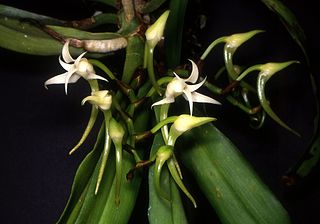
Phragmipedium kovachii is an orchid species found to be new to science in 2001, native to the Andean cloud forests of northern Peru. A species with terrestrial habit and growing in clumps of several individuals, it displays showy pink to purple flowers up to 20 cm (8 in) wide. It is currently considered a critically endangered species by the IUCN, due to overcollection in the wild.

Angraecopsis is a genus of plants in the family Orchidaceae. It was first described by Fritz Kraenzlin in 1900 and given its name on account with the genus' similarity to Angraecum species. Angraecopsis are native to Africa, Madagascar, Réunion, Mauritius and the Comoros. The growth habit is rather small and the leaves emerge from a woody stem.

Bulbophyllum teretifolium is a species of plant in the family Orchidaceae. It is an epiphyte with cylindrical leaves and up to about forty small, white and purplish flowers and is endemic to Cameroon. Its natural habitat is subtropical or tropical, moist montane forests, where it is threatened by habitat loss.

Polystachya subdiphylla is a species of orchid native to Tanzania.

Bolusiella is a genus of flowering plants from the orchid family, Orchidaceae. It consists of 4 currently recognized species that are endemic to sub-Saharan Africa and the Comoro Islands.

Calyptrochilum is a genus of flowering plants from the orchid family Orchidaceae native to tropical Africa, with one species extending into Brazil.

Cardiochilos is a monotypic genus of flowering plants from the orchid family, Orchidaceae. The only species is Cardiochilos williamsonii.

Centrostigma is a genus of flowering plants from the orchid family, Orchidaceae. There are three currently accepted species, all native to Africa:

Changnienia is a genus of flowering plants from the orchid family, Orchidaceae. Only one species is known, Changnienia amoena, native to China.
Clematepistephium is a genus of flowering plants from the orchid family, Orchidaceae. It contains only one known species, Clematepistephium smilacifolium, endemic to the island of New Caledonia. Its closest relative is Eriaxis, also endemic to New Caledonia.

Cyrtorchis is a genus of flowering plants from the orchid family Orchidaceae native to Africa.
Ypsilopus is a genus of flowering plants from the orchid family, Orchidaceae native to Africa.

Neobolusia is a genus of flowering plants from the orchid family, Orchidaceae. It contains 3 known species, all native to eastern and southern Africa.
Nephrangis is a genus of flowering plants from the orchid family, Orchidaceae. It contains two known species, both native to tropical Africa.

Solenangis is a genus of flowering plants from the orchid family, Orchidaceae. It is native to sub-Saharan Africa.
Summerhayesia is a genus of flowering plants from the orchid family, Orchidaceae. It has two known species, both native to tropical Africa.

Phaius tankervilleae, commonly known as the greater swamp-orchid, swamp lily, swamp orchid, nun's-hood orchid, nun's orchid, veiled orchid, Lady Tankerville's swamp orchid or 鹤顶兰 , is a species of orchid native to areas from Asia to islands in the Pacific Ocean. It has large, pleated leaves and tall flowering stems bearing up to twenty five white, brown, mauve and yellow flowers. It was named for Lady Tankerville who was the first person to make the orchid flower successfully in England. It was the first tropical orchid to flower in England.

Rhipidoglossum is a genus of flowering plants from the orchid family, Orchidaceae. It contains 53 species, all from sub-Saharan Africa.
Eulophia stenopetala is a species of orchid endemic to Bhutan. The only material on this species from Bhutan is the holotype specimen collected by William Griffith in Bhutan in 1838 and resides at the Kew Herbarium with catalogue number K000852991. Another specimen without any information on its location is also available at the Naturalis Biodiversity Center with catalogue number U.1466607. The plant is currently considered extinct as numerous attempts to find it in the type locality failed.
Selenipedium dodsonii is a species of flowering plant in the orchid family native to Ecuador, where it grows near rivers in rainforest. It was first described in 2015, and is named after Calaway Dodson. Selenipedium dodsonii is an endangered species, and is listed in Annex II to the Convention on International Trade in Endangered Species of Wild Fauna and Flora (CITES). Plants grow up to 3 m (9.8 ft) tall, and between April and November produce small flowers.













